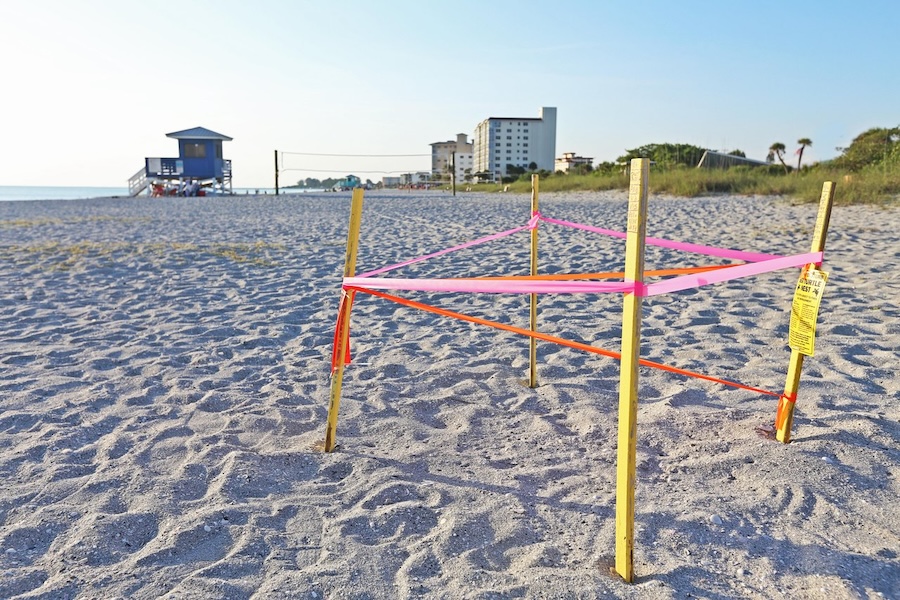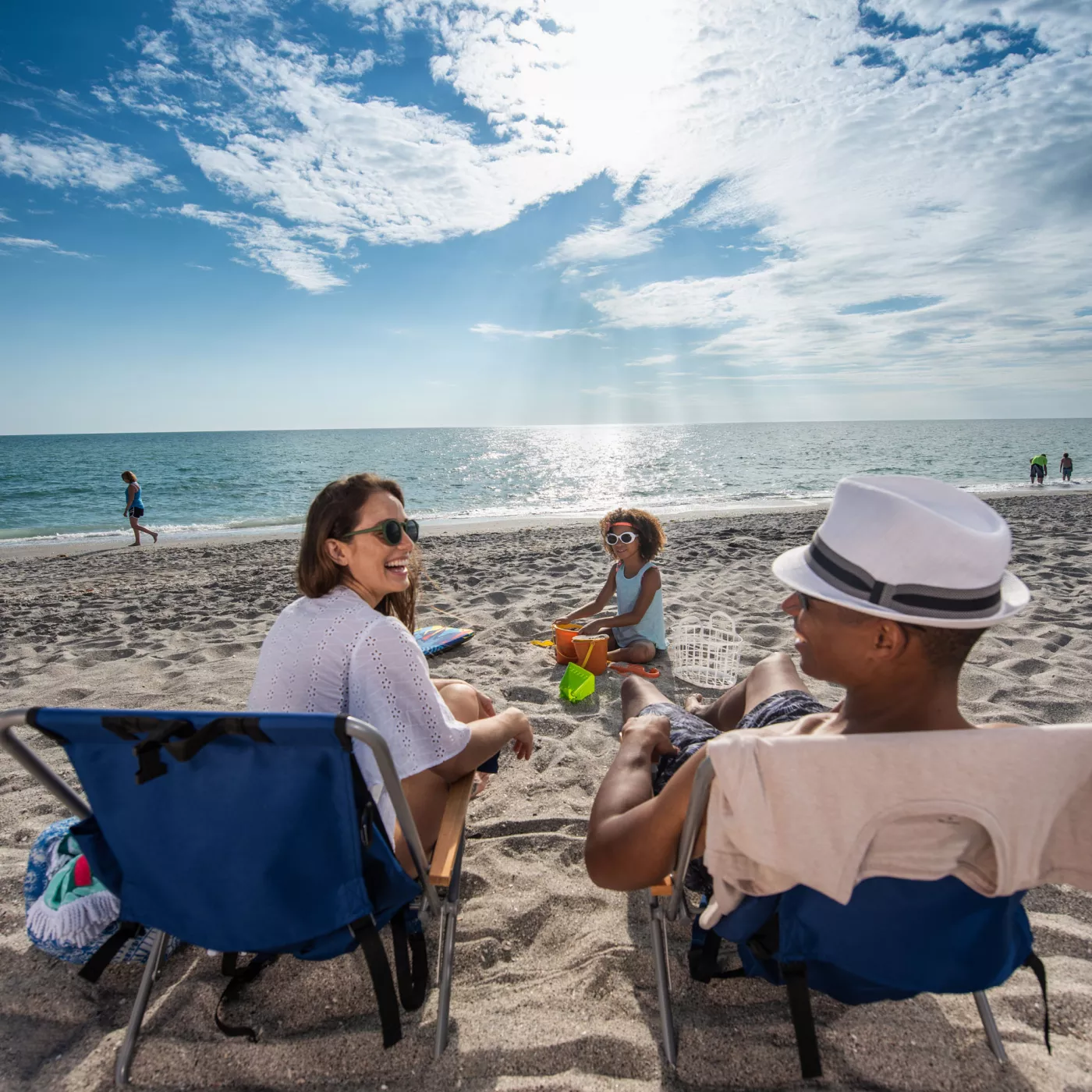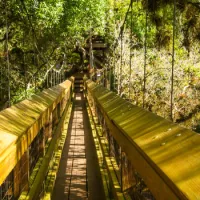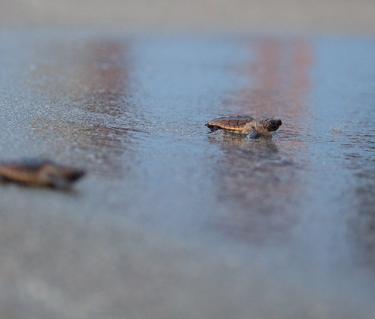Share the Sand: It’s Sea Turtle Nesting Season in Sarasota County
Sarasota County hosts the highest density of loggerhead sea turtle nests in the Gulf. Here's what you need to know about sharing our beaches with these cute critters.
If you head to Sarasota County’s beaches this time of year, you might find you’re not the only one settling in on the sand—and that you have company of the non-human kind.
That’s because May 1 through October 31 is sea turtle nesting season in these parts. During the first half of the season, female sea turtles come ashore to build their nests and lay their eggs. Beginning typically in July, the baby sea turtles start hatching and embark on their journey back into the Gulf.
The Sea Turtle Conservation & Research Program at Mote Marine Laboratory monitors 35 miles of beaches in Sarasota County and neighboring Manatee County daily to check for new sea turtle nests. This work is done in coordination with county, state and federal efforts to conserve sea turtles. Mote’s findings from each nesting season contribute to the statewide picture of sea turtle nesting trends. Loggerhead turtles are a particular focus in this area, since Sarasota County hosts the highest density of loggerhead nests in the Gulf of Mexico.
How to Help Hatchlings
Averaging over 200 sea turtle nests per mile along Sarasota County’s coastline, only 1 out of every 1,000 hatchlings survives to adulthood. Most sadly die from predators, and the exhaustion and starvation caused by disorienting bright, artificial lights.
 Local sea turtle nesting success depends on everyone doing their part to make the process from egg to escape go as smoothly as possible. For visitors, that means following some simple dos and don’ts when you’re at the beach or staying at a beachfront rental or hotel.
Local sea turtle nesting success depends on everyone doing their part to make the process from egg to escape go as smoothly as possible. For visitors, that means following some simple dos and don’ts when you’re at the beach or staying at a beachfront rental or hotel.

When setting up your chairs and umbrellas on the sand, steer clear of active turtle nesting sites, which are marked by wooden stakes and yellow or orange caution tape. If you happen to get lucky enough to see a female nesting or some newborns hatching, observe from afar and try to remain quiet.
Other best practices for sea turtle nesting season include:
- Knock down any sand sculptures you've built and fill in any holes you've dug, as they can become unexpected obstacles for sea turtles en route to the water
- Similarly, remove any furniture, toys, boats, canopies or any other potentially obstructive items when your beach day is over
- Properly dispose of your (or others') trash and food scraps
- Reduce the use of flashlights, tiki torches or cellphones on the beaches at night (shield your phone with your hand if you need to use, or set your screen's back lighting to "off" or the dimmest setting if you're pulling out after dark)
- Avoid taking photographs of nests, as the flash can disorient hatchlings
Recreate in locations away from marked nesting areas

“[Sea turtles] are a protected species, so it’s illegal to interact with them in any way,” says Melissa Bernhard, senior biologist with Mote’s sea turtle conservation and research program. “Adults in the nesting process can be scared away very easily, so it’s best to keep your distance.”
Keeping beaches dark at night is especially important, as hatchlings find the water by heading toward the brightest direction, which is ideally the open night sky over the water. So don’t use flashlights or fishing lamps on the beach at night, turn off outdoor lights if you’re staying at a beachfront property, and close your drapes or blinds in the evening to block light coming from indoors.
“When there are lights on or near the beach, it can override turtles’ natural instincts,” says Bernhard. “They end up crawling directly toward the light, which can waste their energy or lead them into dangerous situations. We want them to get to the water as quickly as possible.”
How to See Sea Turtles (Safely) this Season
To see resident sea turtles in a controlled setting, take a trip to Mote Marine's newest location, Mote SEA. The Florida's Gulf Coast Gallery aims to educate visitors about the inhabitants of the Gulf Coast waters, threats these imperiled creatures face and how Mote has helped protect the sea turtle population for over 40 years.
Visiting Mote SEA, you may also learn more about its Sea Turtle Rehabilitation Hospital, which treats sick and injured turtles in need of some extra help with the hope of returning them back to the wild.

But if you want to get a firsthand look at sea turtle nesting, your best bet is to head out to Longboat Key for a turtle walk conducted by Longboat Key Turtle Watch. Held on Saturdays in June and July, the free walks meet at the public beach access at 4795 Gulf of Mexico Drive and offer info on sea turtle nesting and the chance to observe any recent activity spotted by beach patrollers. No advance registration is necessary; just show up on time and be ready to go at 6:45 a.m.
“You don’t usually see turtles, because it’s rare to see them in the morning, but the walks highlight recent nesting activity and you can see what’s happened on the beach,” says Tim Thurman, president of Longboat Key Turtle Watch. “Our mission is focused on education and awareness about sea turtles and their habitat, and these walks are one of our methods of outreach to the public to help educate them on what goes on."
In July and August, Longboat Key Turtle Watch holds evening events to share information about nest openings and hatchings. Those are usually scheduled about three days in advance, so check the organization’s website or Facebook page for dates.
Sponsor a Nest!
Want to make a real difference for local sea turtles? Through the Longboat Key Turtle Watch, you can adopt or “name” a nest by putting a name of your choice on the back of a stake at a current nesting site.

Sponsoring a nest helps support conservation efforts, public education and ongoing research to protect these incredible creatures. Even cooler: you’ll receive email updates about your nest’s location and progress. Adopt a nest and become part of Sarasota’s sea turtle story.
Another local organization, entirely volunteer-based, is the Coastal Wildlife Club. Their turtle patrollers monitor, document and report on sea turtle activity for the state of Florida every morning for 16 miles from Venice Island's Caspersen Beach to Manasota Key's Stump Pass Beach State Park. Become a member of the Club to support activities and programs, including their CWC Turtle Patrol, public outreach and advocacy. Check out its Facebook page for current nesting data/info and photos throughout the season.
Who You Gonna Call?
If you see a sick, injured or stranded sea turtle in coastal Southwest Florida, please contact Mote Marine Laboratory’s 24-hour hotline through its Stranding Investigations Program at 888-345-2335.
Alternatively, you can call the Florida Fish & Wildlife Conservation Commission at its 24-hour Wildlife Alert Number at 1-888-404-FWCC (1-888-404-3922).

![Boat parking at The Crow’s Nest in Venice [Photo: Lauren Jackson]](/sites/default/files/styles/popular_stories_teaser/public/2023-import/The-Crow%2527s-Nest-cropped__OPT.jpg.webp?itok=ycs37M-O)





